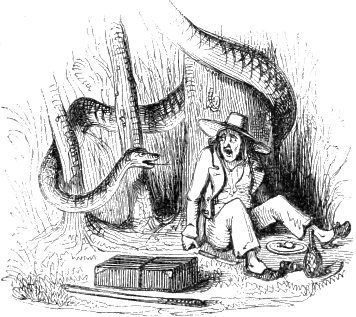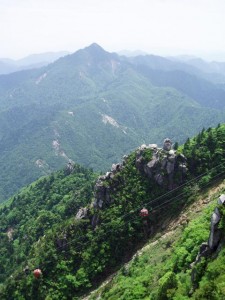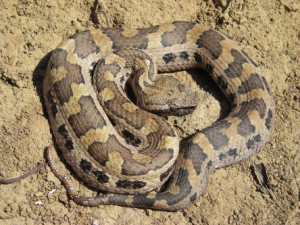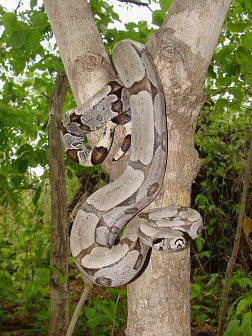The Giant Mystery Snakes Of Japan
Posted by: mystery_man on October 4th, 2012

Snakes. Why did it have to be snakes?
For many people, even a small snake can provoke a fearful reaction or at the very least, unease. Snakes have always instilled a mix of fear and fascination in humans. They play a role in the folklore and legends of cultures all over the world, often represented as being foreboding, evil creatures. Dark and insidious, snakes have haunted us, spawned myths, and slithered through the primal subconscious of mankind since time unremembered.
Terrifying, monstrous serpents may seem to be strictly denizens of the uninhabited jungles and swamps of the world, creatures to be found in the rainforests and jungles of Southeast Asia, South America, or Africa. However, Japan too has a history of giant snake accounts.

There have long been stories of pioneers encountering and being frightened by large snakes lurking in the wilds of Japan. Early settlers of mountainous regions would tell of snakes so large that they could devour dogs and there were occasional tales of doomed travelers being attacked by giant snakes. Peasants of some thickly wooded areas also spoke of a kind of large boa, which they called the uwaba-mi, or yamakachi.

These snakes were rarely seen, but highly feared by locals, and there were circumstantial reports of women, or children being eaten. It was not uncommon for residents of these areas to carry some sort of weapon with them when venturing out alone, in order to ward off any giant snakes they might encounter. Allegedly, these boas were sometimes killed or even captured alive and displayed for money by enterprising villagers.

Accounts of mysterious, large snakes in Japan have existed right up to the modern day. Perhaps one of the best known modern cases of giant snakes in Japan comes from Mt. Tsurugi, located in Tokushima prefecture. This 6,413 ft peak lies within Tsurugi Quasi- National Park, and is the second highest mountain on the island of Shikoku.
Mt. Tsurugi is highly associated with paranormal phenomena, and legend has it that it is a man made pyramid, with some believing that King Solomon’s treasure is located somewhere beneath it. Interestingly, this treasure is supposedly guarded by a colossal snake that will kill any who approach.

Mt. Tsurugi
This snake has been allegedly encountered from time to time by campers and hikers, and is said to be in excess of 12 meters or even more in length. The mountain is known for strange disappearances, and it is said that people who have vanished were in fact devoured by the giant snake. It is said to be highly aggressive when encountered, and will attack unprovoked.
It may seem as if this is all surely pure myth and spooky stories, but is it?
On May 26, 1973, forestry workers on Mt. Tsurugi came across a snake that was described as being as thick as a telephone pole, with shiny black scales and a white underbelly. According to the startled workers, 5 meters (around 16.5 feet) of the snake was protruding from thick underbrush, and they estimated that the full length of the animal would have been a whopping 10 meters (33 feet) or more. The snake was reported to emit a loud chirping noise and piping cry before slithering away into the foliage.
This report caused widespread panic among residents, and some even reported seeing other snakes in the area that were estimated as being 8 meters (26 feet) to 11 meters (36 feet) long.
The following month, in June 1973, local officials responded to escalating fears by mounting a large scale expedition to try and find the giant snake or snakes. Volunteers scoured the mountainside in the vicinity of the sightings, looking for any evidence at all for what people had reported seeing. They found no snake, but they did discover what appeared to be a track left by the creature.
The long track was 40 cm (around 16 inches) across and led through fallen weeds and flattened brush. Those who examined the track said it was undoubtedly that of a large snake of some kind. Bizarrely, a local museum actually claims to have a jawbone measuring 34 cm (13 inches) wide, which is claimed to be from the very same snake. Critics have pointed out that it is merely the jaws of a shark cleverly arranged to resemble a snake’s jaw.
Another mountain, Mt. Tateiwa, in Gunma prefecture, is also said to be inhabited by giant snakes. Giant snake reports occasionally come from the area, and there has been some physical evidence from there as well. A group of hikers on the mountain allegedly came across a discarded skin from a shedding snake. When the skin was investigated, it was believed to have come from a snake that would have been at least 7 meters (23 feet) long.

Mt. Tateiwa
Other areas of Japan have had their own modern day giant snake encounters as well. On January 24, 1987, a 7 meter long snake was seen on a poultry farm in Kochi prefecture. The farmer, a Mr. Asakura Kayoko, reported hearing a commotion coming from one of his chicken coops. When he went to investigate, he found what he at first took to be a log inexplicably lying across the top of the coop. Closer inspection revealed it was in fact a huge snake in the process of eating one of his chickens, and apparently had already eaten others. The farmer’s dogs ended up chasing the snake off of the property.
In Izu prefecture, a giant white snake reported as around 9 meters (29.5 feet) long halted construction of a hotel when it appeared out of the surrounding wilderness. Construction workers were so frightened by the snake that they refused to return to work for several days. An inspection of the area turned up nothing. In this case, perhaps we are dealing with an albino snake of some kind.

What were these people seeing? Truly huge snakes do exist in the wild. Some of the largest species attain incredible sizes.
The overall largest snake known in terms of weight to length ratio is the green anaconda (Eunectes murinus) of South America, which reaches lengths of 6 to 9 meters (19 to 29.5 feet), and weights from 250 kg (551 lbs.) to 500 kg (1,100 lbs.). One recorded green anaconda was 11.4 meters long, and it is thought that there are specimens that occasionally achieve lengths of 10 meters (33 feet).

Green anaconda

Green anaconda
Another species, the reticulated python (Python reticulatus) of Southeast Asia is commonly regarded as the longest snake, being slightly longer on average than the green anaconda, but not as heavily built
These are both huge snakes to be sure, yet like something out of a nightmare, snakes even larger still have occasionally been reported in the far flung, remote corners of the earth. There are even accounts of true giants, snakes in excess of 40 feet long or more. These snakes are sometimes said to attack and kill cattle, and even humans.

Reticulated python

Are the giant snakes seen in Japan escaped exotic snakes such as these, or could the giant snakes seen in Japan represent an unknown endemic species?
Although Japan has a range of indigenous snakes, there is no type of boa or python native to the archipelago. Additionally, there is no known indigenous snake that even approaches the sizes being described in these giant snake accounts.
The largest known snake in Japan is the Hime habu (Ovophis okinavensis), a poisonous pit viper of the southern Ryukyu islands, which reaches average lengths of 1.1 to 1.8 meters (3.6 to 6 feet) long, and a maximum of 3 meters (9.8 feet). It seems unlikely that a snake this size could be mistaken for something 8 to 10 meters in length. The Hime Habu is not only too small to account for the sightings, but it is also only found in southern islands of Japan, and not in the areas where the giant snake reports originated.

Hime Habu
Furthermore, there is no evidence that any sort of snake of this size ever existed anywhere in the Japanese archipelago. If there is indeed an undocumented species of large snake in Japan responsible for these accounts, then it is a type that has no fossil record or any known precedent in the country. It seems in light of the lack of records in Japan for anything like what is described in these giant snake reports, perhaps we have to look at species that have originated from elsewhere.
The most likely culprit for the modern accounts seems to be that people are seeing escaped exotic pets and perhaps overestimating the extreme sizes involved. Several types of pythons and boas are widely available in the Japanese pet trade, so an escaped pet is not beyond the realm of possibility. The relative scarcity of current giant snake sightings reports could be due to the rarity of these animals escaping or being released into the wild.

If we are dealing with escaped exotics of some sort, then the reported sizes imply a specimen of truly enormous size. Even for the largest snakes in the world, green anacondas or reticulated pythons, the sizes described in some of the Japanese giant snake reports would represent the very upper limits of what these snakes are known to achieve. So we are either looking at truly giant escaped captive specimens, or eyewitnesses are misjudging the sizes. Could we be dealing with escaped exotics that subsequently grew to an enormous size?
Indeed snakes such as pythons and anacondas are thought to be able to reach sizes beyond the current record holders. If left to grow uninterrupted in an ideal environment, certainly we could expect to see one of these snakes achieve the lengths reported in the Japanese cases. However, a snake this large would be old indeed, and would need favorable conditions.
The areas where these giant snakes were seen do not have compatible climates for these types of snakes. Pythons and most types of boa are found typically in humid, tropical environments, which would be quite different from the temperate climate found in most of Japan. These snakes tend to have a low tolerance for extremes of temperature, and do not do particularly well in colder environments. Even in captivity, these species need careful monitoring of the temperature in their environment.
It is quite possible that exotic pythons, most boas, and anacondas, would have a difficult time coping under the environmental conditions in places like Mt. Tsurugi and Izu. Although the Mt. Tsurugi and Kochi sightings occurred in the relatively more humid and warmer summer months, perhaps an escaped exotic would not survive the oncoming winter and thus we are left with isolated reports. Perhaps these snakes simply did not survive the cold. The challenge that the Japanese climate would present makes it seem unlikely that an introduced exotic from a tropical habitat would survive long enough to achieve the incredible 8 to 11 meter sizes reported here.

The possible exception to this would be the boa constrictor (Boa constrictor), a moderately large, heavy set snake from Central and South America that can reach sizes of around 4 meters (13 ft) and over 100 pounds (45 kg).
Boa constrictors (above and below) have proven to be much less ecologically specialized and thus more flexible than other types of boas, displaying a high degree of versatility in their choice of habitat and high tolerance for temperature fluctuations. As a result, boa constrictors have a massive territory, with a range extending from Mexico all the way down to Argentina. Within their vast range, boa constrictors are found in a wide variety of environmental conditions, inhabiting everywhere from low lying tropical forests to cooler mountain woodlands and even semi-desert conditions. In the extreme limits of their territory, they are even known to hibernate during the coldest months.

This high versatility and tolerance for varying ecological conditions suggests that a boa constrictor could feasibly survive in the conditions of the Japanese wilderness. However, if the 8 to 10 meter long snakes that were seen are indeed boa constrictors, then they would be far larger than the largest known specimens of that species. Even an abnormally large specimen of boa constrictor would be unlikely to achieve such a size. Again, misidentification of size would most likely be involved such reports.
The question remains whether escaped exotics could possibly explain the more historical accounts of giant snakes in the wilderness. It is more difficult to imagine old time pioneers and settlers of new areas coming across imported snakes from other countries.
The idea of giant snakes roving the remote areas of Japan is as bizarre as it is frightening. Are these things real and if so, are they a threat? As of yet there is no real hard evidence to support the claims, yet as long as people continue to see these phantom serpents, there will be those who look to the forests and wonder.
About mystery_man









I live in Japan and I’ve been to two festivals which involve legends of giant snakes.
This festival on Mt Kurama north of Kyoto dates from the 9th Century when a monk encountered two large snakes. One he killed and the other he spared on the condition to would protect the waters of the mountain. Every year in June they do festival where monks cut at bamboo stalks which represents the snake killed long ago.
Another festival in Niigata involves 2 giant snakes. A woodcutter encountered a giant snake and killed it. He pickled the meat and told his wife not to eat it till he got back. She did anyway and was transformed into a giant snake herself. She planned at one point to destroy the village but the villagers eventually killed her. The villagers make a long snake of bamboo that they parade through the town.